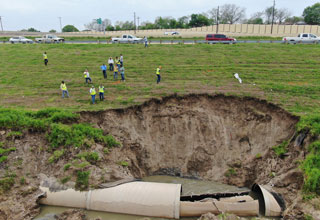The River and the Highway: How an Interceptor Failure Produced Solutions (Source: Underground Construction)
By Reyna Johnson and John Van Hoosier
Very few are unacquainted with the truth of Murphy’s Law: “What can go wrong, will go wrong.” Even fewer infrastructure engineers would disagree with one small change to the age-old law: “What can go wrong, will go wrong, especially when too many existing utilities coexist in a narrow corridor adjacent to a river.”
During the spring of 2020, at the onset of the COVID-19 pandemic, this became a firsthand experience for the Trinity River Authority of Texas (TRA). A 104-inch-diameter fiberglass reinforced polymer gravity interceptor, tucked tightly between the West Fork of the Trinity River and Interstate 30, experienced a critical failure.
A major asset for TRA, this interceptor is just upstream of its largest wastewater treatment facility, where the first hint of trouble was detected thanks to the unintentional sacrifice of endeavoring beavers found on the bar screens.
This 104-inch-diameter interceptor, built in 2008 to replace two parallel, reinforced concrete interceptors, 45 and 66 inches in diameter, experienced a longitudinal failure. While no formal investigation was conducted, it was generally agreed to be the result of a slope stability failure due to additional fill placed above the interceptor for the construction of an outer service road within the interstate right-of-way.
Additionally, pipe stability was further compromised by the river cutting into the bank over time. While the interceptor was originally built 110 feet from the nearest shoulder of the interstate, at the time of failure, the shoulder of the installed access/frontage road was only 55 feet away from the pipe centerline. The soil placed during the interstate widening exceeded the stability angle of the fill material.
Emergency repair
Following the beaver-provided early warning, the owner acted immediately to address the failure and contain the flow within the pipe. Lockwood, Andrews & Newnam, Inc. (LAN), a national planning, engineering and program management firm, was tasked with aiding and providing recommendations on an emergency repair.
Working remotely during various COVID-19 shelter-in-place orders, LAN coordinated with multiple design disciplines to develop the pipe embedment and slope restoration design. Efforts were made to first repair the pipeline under live flow, but the volume, proximity of the river, and slope stability complicated such an installation and presented too much risk.
CLICK HERE TO READ THE COMPLETE STORY

